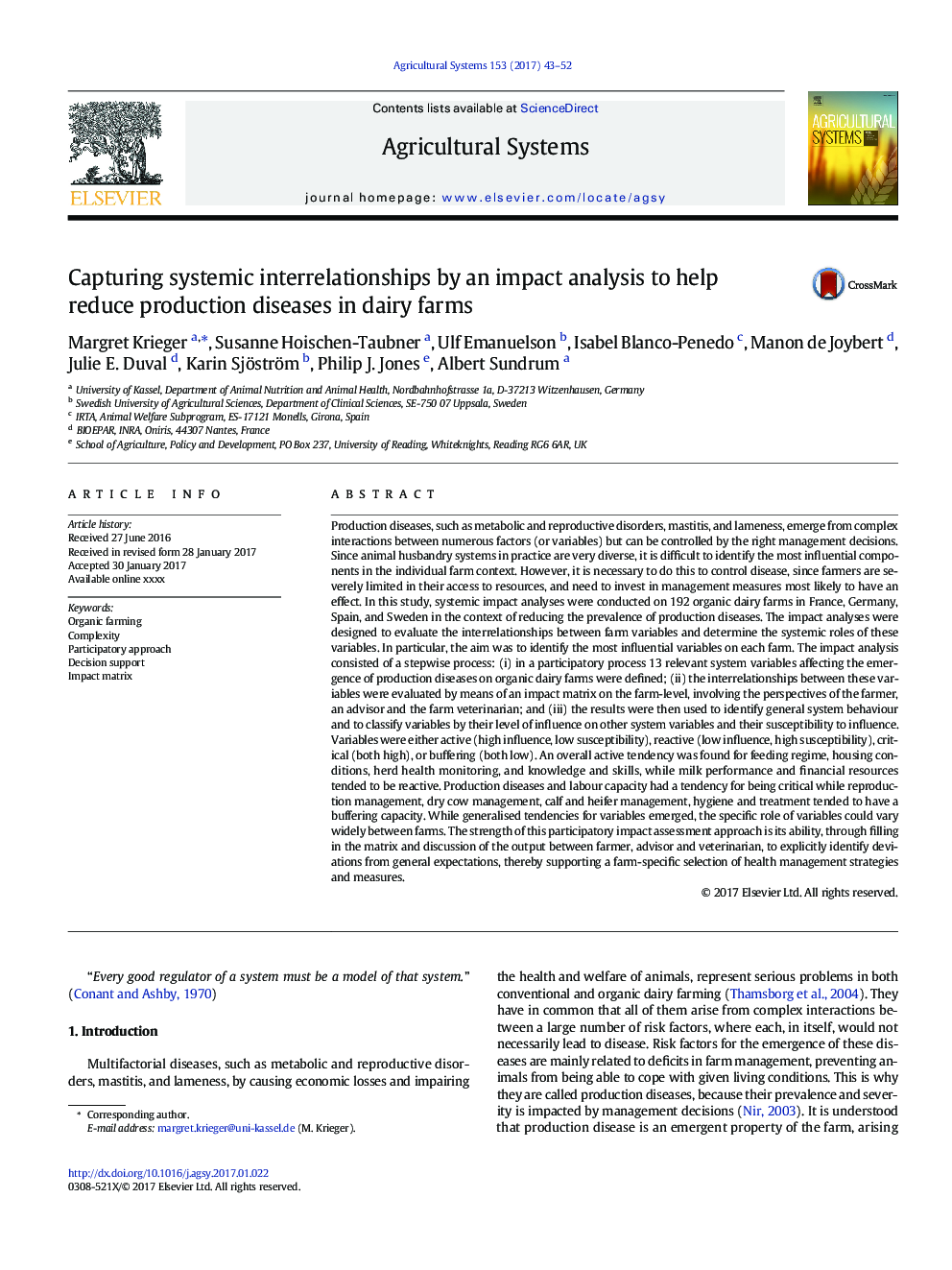| کد مقاله | کد نشریه | سال انتشار | مقاله انگلیسی | نسخه تمام متن |
|---|---|---|---|---|
| 5759742 | 1623217 | 2017 | 10 صفحه PDF | دانلود رایگان |
عنوان انگلیسی مقاله ISI
Capturing systemic interrelationships by an impact analysis to help reduce production diseases in dairy farms
ترجمه فارسی عنوان
گرفتن ارتباطات سیستماتیک با تجزیه و تحلیل تاثیر برای کمک به کاهش بیماری های تولید در مزارع لبنی
دانلود مقاله + سفارش ترجمه
دانلود مقاله ISI انگلیسی
رایگان برای ایرانیان
کلمات کلیدی
کشاورزی ارگانیک، پیچیدگی، رویکرد مشارکتی، پشتیبانی تصمیم ماتریس ضربه،
ترجمه چکیده
بیماری های تولیدی مانند اختلالات متابولیکی و تولید مثل، ماستیت و لنگش، از تعاملات پیچیده بین عوامل متعددی (یا متغیرها) بوجود می آیند، اما می توانند با تصمیمات مدیریت درست کنترل شوند. از آنجایی که سیستم های حیوانی در عمل بسیار متنوع هستند، شناسایی مولفه های تاثیر گذار در زمینه مزرعه فردی دشوار است. با این وجود، لازم است این کار را برای کنترل بیماری انجام دهیم، زیرا کشاورزان در دسترسی به منابع خود به شدت محدود هستند و نیاز به سرمایه گذاری در اقدامات مدیریتی دارند که به احتمال زیاد تاثیر می گذارد. در این مطالعه، 192 مزارع لبنی آلی در فرانسه، آلمان، اسپانیا و سوئد در زمینه کاهش شیوع بیماری های تولیدی، تجزیه و تحلیل تاثیرات سیستمیک انجام شد. تجزیه و تحلیل تاثیر برای ارزیابی روابط بین متغیرهای مزرعه و تعیین نقش سیستماتیک این متغیرها طراحی شده است. به طور خاص، هدف، شناسایی متغیرهای تاثیر گذار بر روی هر مزرعه بود. تجزیه و تحلیل اثر شامل یک فرایند گام به گام بود: (1) در یک روند مشارکتی 13 متغیرهای سیستم مربوطه که بر ظهور بیماری های تولیدی در مزارع لبنی آلوده تأثیر می گذارد؛ (2) روابط بین این متغیرها با استفاده از ماتریس تاثیر در سطح مزرعه، شامل چشم انداز کشاورز، مشاور و دامپزشک دامپزشکی مورد ارزیابی قرار گرفت؛ و (3) نتایج پس از آن برای شناسایی رفتار سیستم عمومی و طبقه بندی متغیرها با استفاده از سطح تاثیر آنها بر سایر متغیرهای سیستم و حساسیت آنها به نفوذ استفاده شد. متغیرها فعال بودند (تاثیر بالا، حساسیت کم)، واکنش پذیری (نفوذ کم، حساسیت بالا)، بحرانی (هر دو بالا) یا بافر (هر دو کم). گرایش عمومی فعال برای تغذیه رژیم، شرایط مسکن، نظارت بر مراقبت از گله و دانش و مهارت ها وجود داشت، در حالیکه عملکرد شیر و منابع مالی به عنوان واکنشی موثر بود. بیماری های تولیدی و ظرفیت کار، تمایل به حیاتی داشتند، در حالیکه مدیریت تولید مثل، مدیریت گاو خشک، مدیریت گوساله و تلیسه، بهداشت و درمان دارای ظرفیت بافر بودند. گرچه تمایلات عمومی برای متغیرها به وجود آمد، نقش خاص متغیرها می تواند به طور گسترده ای بین مزارع متفاوت باشد. قدرت این روش ارزیابی تاثیر مشارکتی توانایی آن از طریق پرکردن ماتریس و بحث در مورد خروجی بین کشاورز، مشاور و دامپزشکی است تا به صراحت انحراف از انتظارات عمومی را شناسایی کند و از این طریق حمایت از انتخاب خاص مزرعه از استراتژی ها و اقدامات مدیریت سلامت .
موضوعات مرتبط
علوم زیستی و بیوفناوری
علوم کشاورزی و بیولوژیک
علوم کشاورزی و بیولوژیک (عمومی)
چکیده انگلیسی
Production diseases, such as metabolic and reproductive disorders, mastitis, and lameness, emerge from complex interactions between numerous factors (or variables) but can be controlled by the right management decisions. Since animal husbandry systems in practice are very diverse, it is difficult to identify the most influential components in the individual farm context. However, it is necessary to do this to control disease, since farmers are severely limited in their access to resources, and need to invest in management measures most likely to have an effect. In this study, systemic impact analyses were conducted on 192 organic dairy farms in France, Germany, Spain, and Sweden in the context of reducing the prevalence of production diseases. The impact analyses were designed to evaluate the interrelationships between farm variables and determine the systemic roles of these variables. In particular, the aim was to identify the most influential variables on each farm. The impact analysis consisted of a stepwise process: (i) in a participatory process 13 relevant system variables affecting the emergence of production diseases on organic dairy farms were defined; (ii) the interrelationships between these variables were evaluated by means of an impact matrix on the farm-level, involving the perspectives of the farmer, an advisor and the farm veterinarian; and (iii) the results were then used to identify general system behaviour and to classify variables by their level of influence on other system variables and their susceptibility to influence. Variables were either active (high influence, low susceptibility), reactive (low influence, high susceptibility), critical (both high), or buffering (both low). An overall active tendency was found for feeding regime, housing conditions, herd health monitoring, and knowledge and skills, while milk performance and financial resources tended to be reactive. Production diseases and labour capacity had a tendency for being critical while reproduction management, dry cow management, calf and heifer management, hygiene and treatment tended to have a buffering capacity. While generalised tendencies for variables emerged, the specific role of variables could vary widely between farms. The strength of this participatory impact assessment approach is its ability, through filling in the matrix and discussion of the output between farmer, advisor and veterinarian, to explicitly identify deviations from general expectations, thereby supporting a farm-specific selection of health management strategies and measures.
ناشر
Database: Elsevier - ScienceDirect (ساینس دایرکت)
Journal: Agricultural Systems - Volume 153, May 2017, Pages 43-52
Journal: Agricultural Systems - Volume 153, May 2017, Pages 43-52
نویسندگان
Margret Krieger, Susanne Hoischen-Taubner, Ulf Emanuelson, Isabel Blanco-Penedo, Manon de Joybert, Julie E. Duval, Karin Sjöström, Philip J. Jones, Albert Sundrum,
